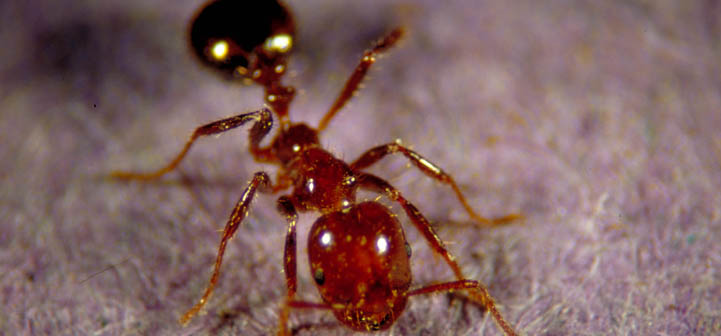Many aspects of imported fire ants can be beneficial, but they can cause many problems.
Impact of Fire Ants on Wildlife
In areas where fire ant populations are very high,
- Ants may reduce populations of other ground-dwelling insects, including native ant species, with which they compete.
- Impact on wildlife may be direct through predation (see What do fire ants eat?) or indirect by ants preying on food, such as insects on which other animals depend. Direct predation has been documented to reduce nesting success of songbirds (see Campomizzi et al. 2009). They also may attack the nestlings of ground-nesting birds and perhaps other wildlife, although impacts on wildlife populations are poorly documented. Fire ants have even been known to climb trees and enter bird nests (Drees 1994).(video). The second, indirect way fire ants impact wildlife has been demonstrated to be the case with the endangered Attwater’s prairie chicken (Morrow et al. 2015).
- For more information about imported fire ants in wildlife areas, see Fire Ant Project Fact Sheet, Managing Red Imported Fire Ants in Wildlife Areas.
- Related article: How Can I Protect Bluebird Nests from Attack by Imported Fire Ants
Impact of Controlling Fire Ants
- A secondary effect of fire ants is the misuse or overuse of insecticides applied in an attempt to reduce their populations. This can lead to surface runoff water contamination (See Fire Ant Project Fact Sheet, Estimated Amounts of Insecticide Ingredients Used for Imported Fire Ant Control Using Various Treatment Approaches).
Economic Impact of Fire Ants
- Imported fire ants (Solenopsis invicta and Solenopsis richteri) are invasive species that cause $6.7 billion in annual losses in the United States.
- Imported fire ants inflict painful stings and can kill human beings.There are large social and medical costs associated with this pest.
- The large mounds they build dot the landscape (average of 60 mounds per acre from Louisiana eastward, and 300 mounds per acre in Texas). The mounds are unsightly and can damage mowers and combines.
- The ants have an affinity for electrical equipment and can cause failures when they interfere with switching mechanisms, chew on insulation, and fill utility boxes with soil for nesting. Fire ants invade electrical equipment, causing short circuits and equipment failures.
- They cause ongoing expense to turfgrass managers. Currently, a USDA APHIS quarantine covers 320,000,000 acres in 14 U.S. states or territories.
- Resources:
- An Economic Impact of Imported Fire Ants in the U.S., [PDF]
- Economic Assessments of Red Imported Fire Ant on Texas’s Urban and Agricultural Sectors, [PDF]
- Fire Ant Damage and Control at Texas Golf Courses
- The Economic Impact of the Red Imported Fire Ant on the Metroplexes of Texas
- The Economic Impact of the Red Imported Fire Ant on the Homescape, Landscape, and the Urbanscape of Selected Metroplexes of Texas
- The Economic Impact of Red Imported Fire Ants in Rural Texas, 2006
- The Statewide Economic Impact of Red Imported Fire Ants in Texas: A Part of the Texas Fire Ant Initiative 1999-2001
Impact of Fire Ants on Agriculture
- In agriculture, their tall, hardened mounds can interfere with field working machinery.
- Although fire ants eat certain insects, they protect and encourage population growth among sucking insects such as aphids, scales, mealybugs, and others that produce the sugary liquid called honeydew.
- The ants feed on the honeydew rather than eat the insects that produce it. Thus, they can increase the need for insecticide use for these pests in certain crops such as cotton and ornamental crop nurseries.
|
quail egg |
with pesticide application apparatus, on golf course. |
Two fawns resting in the grass. |
Impact of Fire Ants on Fish
Autopsies of fish have shown that their stomachs were packed with flying (winged) imported fire ants. As noted in the answer to the question “Why do flying fire ants land in my swimming pool?” flying ants are attracted to the reflective surfaces of the water. Thus, fire ants can provide an abundant food supply for fish. When fish consume many fire ants, the large quantity of food and the venom from stings could combine to cause the kills.
More research is needed to definitively answer this question. Frequent reports attribute fish kills to fire ants, but debate continues as to whether fire ants actually cause the fish kills. Most of the reports are unfounded, but a few cases have been verified.




